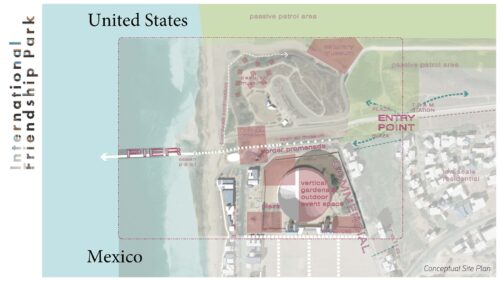It’s hard to ignore the rust colored border fence separating Tijuana from San Diego that stretches all the way into the Pacific Ocean. El Parque de la Amistad, Friendship Park, is a binational park with both a Mexico and a U.S. side located along the border fence just east of the Pacific coastline. On the Tijuana side, the park sits beneath El Faro, the Lighthouse, just adjacent to the beach. On the U.S. side, Friendship Park is a small area that resides inside of Border Field State Park in San Diego. The park has always been a meeting place for separated friends and family who meet at Friendship Park to reunite and spend time together despite the border that separates them.
The Current State of Friendship Park
The park is open 24 hours on the Tijuana side and there’s the famous “Monument 258” and a small garden. On the U.S. side, the park is usually open Saturday and Sunday from 10am-2pm, but is currently closed because of COVID. The U.S. side of Friendship Park is sandwiched between two border fences. It’s located in the US federal patrol zone so visitors need to be prepared to show their ID to border patrol agents. During summer months, visitors can pay US$7 per vehicle to drive through Border Field State Park and right up to Friendship Park. Other times throughout the year, the road to the park is closed due to flooding and visitors must walk 30-45 minutes from the parking lot to Friendship Park.

Left: Monument 258 c. 1890. Right: First Lady Pat Nixon reaching across the border fence at the dedication of Border Field State Park in 1971.
The History of Friendship Park
In 1849, a monument was put in place by the binational boundary commission (established by the treaty of Guadalupe-Hidalgo which had ended the Mexican-American war a year earlier) to signify the new international boundary between the U.S. and Mexico. This location, next to the Pacific Ocean, was called Monument Mesa, and is considered the birthplace of the border. Crossings between the two countries were largely unregulated at this time and there was no formal border line, only the monument demarcated the difference between the U.S. and Mexico.
A refurbished monument was placed in this spot in 1894 as a part of new border charting work done by the International Boundary. The monument was dubbed Monument 258 (there are 258 of these monuments along the 2,000-mile Mexico/US border) and is the one that stands there today. Its base sits directly on the international boundary inscribed on each side: “Boundary of the United States” on one side, and “Punto Límite de la Republica de México” on the other.
The border here has changed significantly over the years from a wide-open space to a wire demarcation, to a fence, to the wall that stands there today. First lady Pat Nixon dedicated the Border Field State Park (the state park on the U.S. side that Friendship Park is located within) in 1971 and famously stepped across the border to embrace Mexican children. She said “I hope there won’t be a fence here too long. I hate to see a fence anywhere.”
The Future of Friendship Park
Friendship Park on the U.S. side continues to change, evolving farther away from the pleasant park it once was. The park is divided by a thick impenetrable wall that now separates the two sides of the border. There’s a renewed “Build That Park” initiative headed up by The Friends of Friendship Park that is working to reestablish Friendship Park. The Friends of Friendship Park is a non-partisan, grassroots coalition of individuals and organizations advocating for increased public access to the historic meeting place on the US-Mexico border. The new border wall being constructed is currently threatening Friendship Park as well.
To Learn More About Friendship Park or to Get Involved
Learn more about the history of Friendship Park or get current, detailed information about visiting on the Friendship Park website. To get the latest news about petitions and other activities, be sure to follow them on Facebook. To learn more or get involved with the new Build That Park. Initiative, head to their website or follow them on Facebook.




I remember when you could go up to the border and shake people’s hands on the other side of the border. This current situation is really xenophobic. It makes the United States look really insular and afraid.